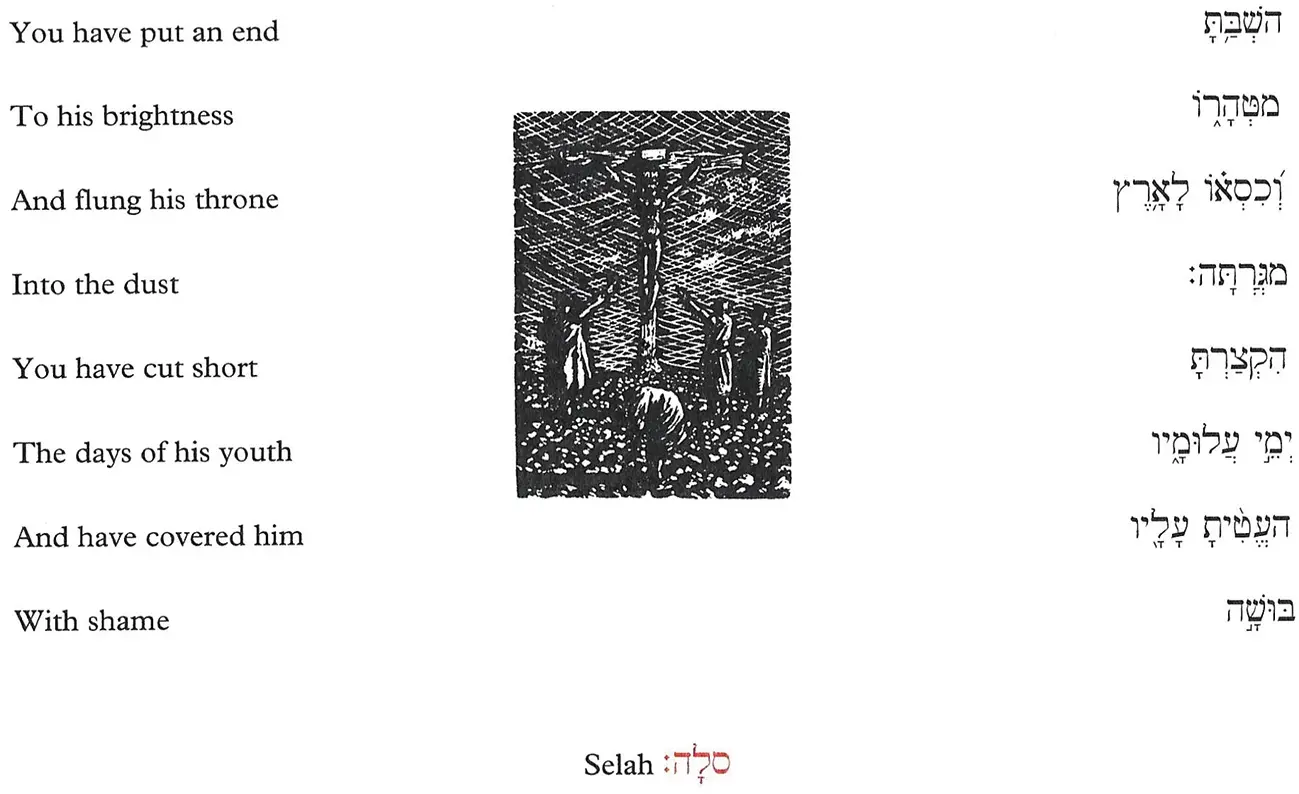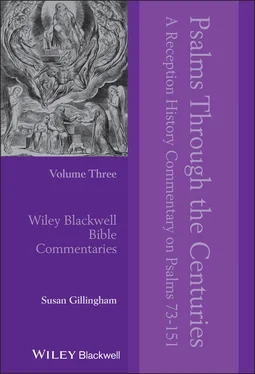The second image is by Roger *Wagner, who, at the very end of Book Three of his Book of Praises illustrates verse 39 with an image of Christ on the cross, as the rejected Messiah, fitting with the tone of despair at the end of psalm, and giving it some correspondences with the visual exegesis of the end of Psalm 88 earlier (Figure 6). 292This resonates with the more traditional view in reception history that the psalm ends on a negative note of despair.

FIGURE 6 Roger Wagner, Ps. 89:44–45: The King and the Cross .
Source : Wagner, R. 2013. The Book of Praises: A Translation of the Psalms. Book Three . Oxford: The Besalel Press.
Like Psalms 2, 45 and 110, the reception of this psalm points to key differences of Jewish and Christian reception, and their different interpretations of the everlasting or temporal nature of the Davidic covenant, and of the identity of the one who is to inherit the promises of an everlasting throne.
Before moving on to assess the reception history of the psalms in Book Four, it is important to finish with some observations about Book Three. One is to note a very different tenor than that in Books One and Two, which through the collections of laments, thanksgiving and didactic psalms performed a prayerful and ethical guide to obedience and piety. Very few psalms in Book Three have been used in this way: other than Psalm 73, the only other obvious exceptions are Psalm 86, a ‘Psalm of David’, and perhaps also Psalm 84. Following from this, a second observation is that the reception history of Book Three, through the rich resources of liturgy, illumination, music and poetry, has been more concerned with theological questions about the character of God and his dealings with his entire people. A persistent concern, especially in Jewish reception, has been about making sense of a broken past in order to face the future. This ‘backwards look’ has been the key feature of Book Three: only in Books Four and Five is there a more decisive future perspective. Finally, because of this interest in the fate of the whole community, the memory is primarily focussed on the covenant made with Moses and the traditions of Genesis and Exodus (Psalms 74–78 [other than 78:67–72], 79–83), and only in the latter part of Book Three does the attention begin to focus more on David (Psalms 86 and 89). This dialogue between the covenants with Moses and David is a critical feature of Book Four, with its additional element of the ‘High Kingship of Yahweh’. Psalm 90 thus returns to the interest in Moses and the vicissitudes of the people at a time of loss.
Psalms Through the Centuries: A Reception History Commentary on Psalms 73–151, Volume Three,First Edition. Susan Gillingham. © 2022 John Wiley & Sons Ltd. Published 2022 by John Wiley & Sons Ltd.
1 1 For example, the references to ‘Joseph’ (77:15; 78:67; 80:1; 81:5), to ‘Ephraim’ (78:67; 80:2) and to the ‘God of Jacob’ (75:9; 76:6; 81:1,14).
2 2 Psalms 74 and 79 seem to lament the destruction of Jerusalem; whilst Psalms 75–76 and 82 speak of God’s presence in Zion.
3 3 See deClaissé-Walford 1997: 79–80; Cole 2000: 9–14, 231–5.
4 4 See Pavan 2014: 127–8 and 183–84.
5 5 See Pavan 2014: 127–8 (on Psalms 73–83) and 183–4 (on Psalms 84–89); also 185–270 (on Psalms 78 and 89 being pivotal psalms).
6 6 See Gillingham 2018: 256.
7 7 This order of instruction/communal lament/divine response/individual lament is mirrored in Psalms 78–83, as will be seen shortly.
8 8 Brueggemann 1991: 81–88.
9 9 For a clear overview of this problem, see Tate 1990: 228.
10 10 Bons 2008: 139.
11 11 Schaper 1995: 70.
12 12 Pietersma 2000: 70–71.
13 13 Stec 2004: 143–44.
14 14 See ‘Prayer of Job and David’ 3.2.3 and 3.3.5 in FC 65:369–74, in ACCS VIII: 101–03.
15 15 See ‘Prayer of Job and David’ 3.10.27–28 in FC 65:385–7, in ACCS VIII: 109–10.
16 16 See Sermon 15A.2 cited in WSA 3:1:332, in ACCS VIII: 108.
17 17 Neale and Littledale 1874–79: 2/466–67.
18 18 Neale and Littledale 1874–79: 2/479.
19 19 Corrigan 1992: 14; also fig. 17.
20 20 See https://psalter.library.uu.nl/page/90.
21 21 See https://bit.ly/31O0u5N.
22 22 See https://www.albani-psalter.de/stalbanspsalter/english/commentary/page213.shtml.
23 23 https://www.ccel.org/h/herbert/temple/Collar.html.
24 25 See also Kinnamon 1981: 21–23.
25 25 From Pilgrim’s Progress, Tenth Stage. See http://www.ccel.org/ccel/bunyan/pilgrim.iv.x.html.
26 26 Prothero 1903: 305. See http://www.hymnary.org/text/in_age_and_feebleness_extreme.
27 27 See Dowling Long and Sawyer 2015: 162.
28 28 The lyrics are at http://genius.com/894873; for the performance see https://www.youtube.com/watch?v=xEnKURp0hlc.
29 29 See Buber 1953: 39–41, cited in Levine 1984: 217. See also Magonet 1994: 164–78.
30 30 Dombkowski Hopkins 2016: 235.
31 31 See pp. 2–3.
32 32 See Feuer 2004: 925.
33 33 See Feuer 2004: 925–26.
34 34 Taken from *Sforno, cited in, Feuer 2004: 926.
35 35 Prothero 1903: 217–18.
36 36 Miller 1994: 281.
37 37 City of God 17.4: CG 722–23, in ACCS VIII:116.
38 38 Expositions of the Psalms 73:13, ACW 52:218 and ACCS VIII:117.
39 39 See https://psalter.library.uu.nl/page/91.
40 40 See https://www.albani-psalter.de/stalbanspsalter/english/commentary/page216.shtml. The Khludov, Pantokrator and *Barberini Psalters also illustrate verse 13 through the context of Jesus’ baptism. See Corrigan 1992: 91.
41 41 See Corrigan 1992: fig. 87 for Pantokrator (p. 290) and fig. 88 for Khludov (p. 291).
42 42 See http://www.bl.uk/manuscripts/Viewer.aspx?ref=add_ms_19352_f096r.
43 43 See Hamlin et al. 2009: 139–40; also Rathmell 1963: xxii, who notes similar forestry imagery was used by Mary Sidney in Psalm 92.
44 44 Wieder 1995: 110–11.
45 45 Feuer 2004: 925–26.
46 46 That is, if the verb ‘cut off’ is to be read as first not third person. We may note some correspondences with Psalm 82 which also contains two divine speeches.
47 47 See Braude 1959: 2/11–12.
48 48 See Feuer 2004: 945.
49 49 See Feuer 2004: 943–44.
50 50 See Expositions of the Psalms 74.9 in ACW 52:229, ACCS VIII: 120.
51 51 See Neale and Littledale 1874–79: 2/508, citing *Thomasius on *Aquinas.
52 52 See Neale and Littledale 1874–79: 2/510. See also Expositions on the Psalms 74 (75).4 in PL 36. 948–49 on the way Augustine reads this Psalm as ‘Christ our Head’ speaking for us, and ‘Christ our Body’ speaking with us.
53 53 Dowling Long and Sawyer 2015: 269.
54 54 See http://www.cgmusic.org/workshop/newver/psalm_75.htm.
55 55 Gillingham 2008: 161–62.
56 56 See https://psalter.library.uu.nl/page/93.
57 57 See https://www.albani-psalter.de/stalbanspsalter/english/commentary/page218.shtml.
58 58 See http://themuseumofpsalms.com/product/psalm-75/.
59 59 See the discussions on Pss. 46 and 48 in Gillingham 2018: 276–84 and 288–92.
60 60 See Tate 1990: 262–63 which focusses especially on verses 4 and verse 11.
61 61 See Stec 2004: 148–49.
62 62 Feuer 2004: 947–48.
63 63 See Feuer 2004: 948, referring also to *Midrash on Song 4:19.
64 64 Neale and Littledale: 2/517.
65 65 See Neale and Littledale 1874–79: 2/526.
66 66 Expositions on the Psalms 75:9–10; ACW 52:235–6; in ACCS VIII:122–23.
67 67 Dowling Long and Sawyer 2015: 44.
Читать дальше













